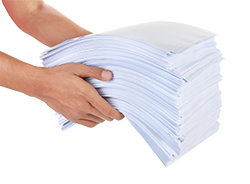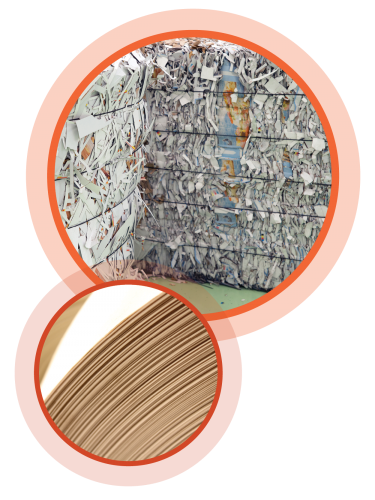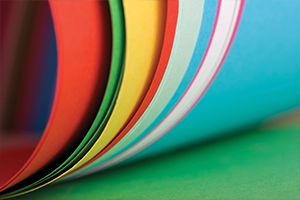 Key Concepts: Forests are the source of products that people use every day (from paper and tissue, to furniture, food, clothing, their house structure, and many more). [PLT Forest Literacy Framework, Concept 2.B.3]
Key Concepts: Forests are the source of products that people use every day (from paper and tissue, to furniture, food, clothing, their house structure, and many more). [PLT Forest Literacy Framework, Concept 2.B.3]
Objectives: Provide opportunities and materials for learners to:
- Describe the steps of the papermaking process.
- Identify the importance of trees as a renewable resource.
Session Time: 50 minutes
Setting: Indoors or Outdoors
 Many products we use are derived from trees. Cellulose is the major component of wood and is used to make paper and paper products, including books, wrappers, cereal boxes, and newspapers.
Many products we use are derived from trees. Cellulose is the major component of wood and is used to make paper and paper products, including books, wrappers, cereal boxes, and newspapers.
The process for making paper was invented in China in the second century A.D. Until the Industrial Revolution, paper was made one sheet at a time. Today’s modern machines can make a sheet of paper 26 feet (8.8 m) wide and nearly 40 miles (64 km) long in just one hour!
During the papermaking process, mill machines debark and shred logs into millions of chips the size of breakfast cereal. These are broken down with chemicals, steam, and pressure to make a pulp that is sprayed onto a wide, moving wire screen. The water in the pulp drains through the screen holes, forming a damp mat of wood fibers, which is the paper. Steam-heated rollers dry the paper.
Recycled paper is made by breaking down waste paper into pulp, which is then formed into paper products. In this activity, learners recycle waste paper to make new paper.
Materials:
Scrap paper (paper towels, construction paper, and toilet paper work well); a large bowl; a wooden frame 5” x 7” (13 cm x 18 cm) or 8” x 10” (20 cm x 25 cm); nylon or wire screen; a stapler; a plastic basin at least 2.5 gallons (9.5 liters) in capacity and larger than the frame; blender; sheets of newspaper; sponge; strainer. Optional: Colored paper; liquid starch; rubber gloves; small dried leaves, seeds, or flowers; plastic bags for transporting wet paper.
Get Ready:
- Plan to have another adult lead an alternate activity (like a site tour) while you supervise the papermaking with small groups of learners. Set up a papermaking station outside or in a space that won’t be damaged by water.
- Remove any plastic or staples from the scrap paper and tear it into small pieces (1-inch or 2.5-cm squares). Soak the paper in hot water in the large bowl for at least 30 minutes.
- Tightly staple or tack nylon or wire screening to the wooden frame, making a “deckle,” which is the surface on which you will layer the fibers. Select here for helpful papermaking deckle tutorials.
- Plan to collect the leftover pulp in a strainer at the end of the activity and recycle it or freeze it in a plastic bag for future use— do not pour it down the drain.
 Introduce
Introduce
Ask learners to name things they’ve used today that comes from trees. Ask what they think paper is made of and how it is made. Point out that wood, food, and paper are three of the main kinds of products people get from trees. Explain that they’ll find out by making paper themselves.
Experience
Assist learners in making paper:
- Fill a blender halfway with warm water, adding a handful of soaked paper scraps. Blend at medium speed until the pulp has a soupy consistency.
- Pour the mixture into the large basin and fill it with warm water, mixing thoroughly. Adding a few ounces of liquid starch will help make the paper firm. They may add dried leaves, seeds, or flowers for interest.
- Slide the deckle into the basin, putting some pulp onto the screen and, still holding the deckle underwater, gently moving it back and forth to get an even layer of fibers on the screen.
- Lift the deckle out of the mixture, keeping it flat.
- Allow the deckle to drip until most of the water has drained off, leaving a uniform layer of pulp mixture on the deckle. Press the pulp gently with a hand to squeeze out excess moisture (wearing rubber gloves helps). Soak up any excess water from the bottom of the screen with a sponge.
- Place sheets of newspaper onto a flat surface and turn the deckle paper-side-down. Lift the deckle gently, tapping the screen to release the paper onto newspaper.
- Instruct learners to let the paper dry naturally overnight and then gently peel the paper off the surface. (If they must transport the wet paper, have them carefully roll up the new paper and newspaper together, and place into a plastic bag.)
Connect
Ask learners what other products come from trees. Talk about the idea of trees as a renewable resource.
Ask: What can people do to care for trees? How can we make sure we always have trees for the products we need?
TAKE ACTION!
Invite learners to research innovative ways that people use forest fiber—such as cleaning, construction, packaging, or clothing—as a renewable resource to tackle global issues that could otherwise threaten environmental health (such as single use plastics).


 Key Concepts: Forests are the source of products that people use every day (from paper and tissue, to furniture, food, clothing, their house structure, and many more). [PLT Forest Literacy Framework, Concept 2.B.3]
Key Concepts: Forests are the source of products that people use every day (from paper and tissue, to furniture, food, clothing, their house structure, and many more). [PLT Forest Literacy Framework, Concept 2.B.3] Many products we use are derived from trees. Cellulose is the major component of wood and is used to make paper and paper products, including books, wrappers, cereal boxes, and newspapers.
Many products we use are derived from trees. Cellulose is the major component of wood and is used to make paper and paper products, including books, wrappers, cereal boxes, and newspapers. Introduce
Introduce